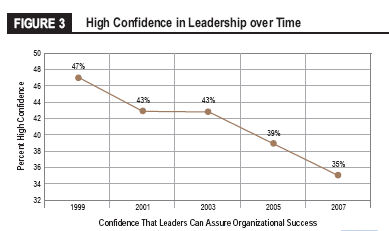Despite much advice from the $15 Billion Leadership Industry (business schools, seminars, books, tapes, journals), it seems that many so called leadership experts; business books and publications failed us.
…corporate America is in crisis, confidence in leaders is plummeting, and a recent DDI survey finds that more than one-third of all new leaders fail. What’s wrong with leadership development?
Leadership Development: Does Not Fit All
And it gets worse — in their recent report on leadership development, Global Leadership Forecast 2008|2009 Development Dimensions International (DDI), has a sobering chart on the declining confidence that HR professionals have in the ability of leaders to insure financial success.



Reasons for this include such items as:
- Lack of CEO involvement
- Leadership development not linked to strategic objectives
- As Jay Conger, one of the best thought leaders (see The Productization of Leadership Development) suggested: companies look for quick fixes
- Or perhaps the problem is what the doyen of business thought leaders, Warren Bennis, once said, “I don’t think [leadership] is yet a ‘field’ in the pure sense. There are something like 276 definitions of leadership.”
To some extent, all of these are valid reasons why Leadership Development programs don’t deliver. However, I think the real culprit is that these programs do not adequately capture the context in which a leader works. That context is the complex soup —
- of external factors such as the industry environment, political and social trends, regulation;
- of internal factors such as the corporate culture, administrative systems, “tone at the top”
These factors combine into a context that is indigenous to each company.
“Yes, business leaders need to have certain personal characteristics to be successful, but it is often the application of those characteristics within a specific context that define great success. It’s not only who you are, but when and where you are.”
Tony Mayo, co-author of “In Their Time: The Greatest Business Leaders of the Twentieth Century” (see The importance of context for successful leadership)
Mayo gives a real example of the importance of the context of leadership —
The list of once-successful CEOs who have failed in new business settings is long. Bob Nardelli is a prime example. His stellar career and track record at General Electric seemed to be just what The Home Depot needed. Nardelli’s success at GE was predicated on a command-and-control leadership style that fit that company. That same style was less suited to the participatory culture of Home Depot. Nardelli failed to recognize the importance of Home Depot’s culture and was unable to survive despite certainly having the raw talent to manage the company.
The context of a company is found primarily in the hearts and minds of managers in the C-Suite. One of the best ways to tap this valuable source of intelligence for developing new leaders is mentoring. The next post will profile companies who use leaders as teachers in Leadership Development.
Ed Konczal has an MBA from New York University's Stern School of Business (with distinction). He has spent the last 10 years as an executive consultant focusing on human resources, leadership, market research, and business planning. Ed has over 10 years of top-level experience from AT&T in the areas of new ventures and business planning. He is co-author of the book "Simple Stories for Leadership Insight," published by University Press of America.



I really want to work on my leadership skills and this might really help. Thank you for posting this.